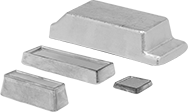Casting Metals

Melt and pour these alloys into molds to create metal parts and prototypes.
Bismuth and indium alloys expand slightly as they solidify, pushing into the crevices of a mold to produce detailed replicas. These alloys are useful for repairing dies, creating fusible links, and holding delicate parts for machining. Indium alloys have a low melting temperature so they can be cast in molds made from glass, quartz, mica, and ceramic.
Lead can be used for caulking, castings, and hot-dipped coatings.
Lead-base babbitt is a soft alloy. Use it to cast light-load bearings. It has superior antifriction properties.
Lead hammer metal is commonly used to cast nonmarring hammer heads. This ductile material is hard and won't chip.
Tin-base babbitt is used to cast bearings for high-speed, high-wear applications and can withstand heavy, sustained loads. It has a higher melting temperature than lead-base babbitt.
Zinc alloy is nonshrinking and corrosion resistant. Parts cast from this material are easy to machine.
Silicon-bronze alloy is often used to cast gears, propellers, bells, and plaques. It renders an excellent surface finish.
Aluminum alloy has good castability, weldability, and corrosion resistance. Castings made from aluminum can be heat treated to increase hardness and strength.
Material Composition | Approximate | ||||||||||
|---|---|---|---|---|---|---|---|---|---|---|---|
| Melting Temperature, °F | Bismuth | Lead | Tin | Cadmium | Thick. | Wd. | Lg. | Wt., lbs. | Each | ||
| 158° | 50% | 27% | 13% | 10% | 1/2" | 3" | __ | 1 | Hex Ingot | 0000000 | 000000 |
| 160° | 43% | 38% | 11% | 8% | 1/2" | 1 1/2" | 4 1/2" | 1 | Sheet and Bar | 0000000 | 00000 |
| 203° | 53% | 32% | 15% | __ | 3/4" | 1" | 3" | 1 | Sheet and Bar | 0000000 | 00000 |
| 255° | 56% | 44% | __ | __ | 1/2" | 3" | 3" | 1 | Sheet and Bar | 0000000 | 00000 |
| 281° | 40% | __ | 60% | __ | 1/2" | 1 1/2" | 4 1/2" | 1 | Sheet and Bar | 0000000 | 00000 |
| 281° | 58% | __ | 42% | __ | 1/2" | 1 1/2" | 5 1/2" | 1 | Sheet and Bar | 0000000 | 00000 |
Approximate | |||||||||
|---|---|---|---|---|---|---|---|---|---|
| Melting Temperature, °F | Material Composition, Lead | Thick. | Wd. | Lg. | Wt., lbs. | Specifications Met | Each | ||
| 621° | 99.9% | 1" | 2" | 8 3/4" | 5 | Ingot | ASTM B29 | 000000 | 000000 |
Material Composition | Approximate | |||||||||
|---|---|---|---|---|---|---|---|---|---|---|
| Melting Temperature, °F | Lead | Tin | Antimony | Thick. | Wd. | Lg. | Wt., lbs. | Each | ||
| 459° | 80% | 5% | 15% | 1 1/8" | 1 5/8" | 7 1/2" | 5 | Sheet and Bar | 0000000 | 0000000 |
Material Composition | Approximate | ||||||||
|---|---|---|---|---|---|---|---|---|---|
| Melting Temperature, °F | Lead | Antimony | Thick. | Wd. | Lg. | Wt., lbs. | Each | ||
| 430° | 94% | 6% | 1 1/8" | 1 5/8" | 6 5/8" | 5 | Sheet and Bar | 0000000 | 000000 |
Material Composition | Approximate | |||||||||
|---|---|---|---|---|---|---|---|---|---|---|
| Melting Temperature, °F | Tin | Antimony | Copper | Thick. | Wd. | Lg. | Wt., lbs. | Each | ||
| 669° | 89% | 7% | 4% | 1 1/2" | 2" | 5 1/2" | 4 1/2 | Sheet and Bar | 0000000 | 0000000 |
Material Composition | Approximate | |||||||||
|---|---|---|---|---|---|---|---|---|---|---|
| Melting Temperature, °F | Zinc | Copper | Aluminum | Thick. | Wd. | Lg. | Wt., lbs. | Each | ||
| 740° | 95% | 0.1% | 4% | 1 1/4" | 2 3/4" | 6 1/4" | 4 1/2 | Ingot | 000000 | 000000 |
Material Composition | |||||||
|---|---|---|---|---|---|---|---|
| Melting Temperature, °F | Zinc | Copper | Silicon | Approximate Wt., lbs. | Each | ||
| 1,780° | 4% | 92% | 4% | 1 | Ingot | 0000000 | 000000 |
Material Composition | Approximate | |||||||||
|---|---|---|---|---|---|---|---|---|---|---|
| Melting Temperature, °F | Aluminum | Silicon | Iron | Thick. | Wd. | Lg. | Wt., lbs. | Each | ||
| 1,035° | 92.5% | 7% | 0.3% | 4" | 4" | 18" | 20 | Ingot | 00000000 | 0000000 |
Bar Solder for Food Service Equipment

This solder is commonly used in solder melting pots. It's composed of pure tin, so it is safe for use with food service equipment. This solder does not have a flux core, so you can choose the flux that works best for your application. It is lead-free, so it is safer to use than leaded solder and helps meet industry regulations.
Material Composition | ||||||||||
|---|---|---|---|---|---|---|---|---|---|---|
| Solder Composition | Tin | Lead | Melting Temperature, °F | Solder Type | Lg. | Wd. | Ht. | Wt., lbs. | Each | |
For Joining Brass, Bronze, Copper, Stainless Steel, Steel | ||||||||||
| Sn100 | 100% | 0% | 450° | Flux Required | 11 1/2" | 1" | 1/2" | 1 | 0000000 | 000000 |

























